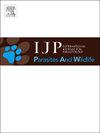Two-year longitudinal study of Eimeria uekii and Eimeria raichoi oocyst shedding in Japanese rock ptarmigans (Lagopus muta japonica)
IF 2.2
3区 医学
Q3 ECOLOGY
International Journal for Parasitology-Parasites and Wildlife
Pub Date : 2025-05-27
DOI:10.1016/j.ijppaw.2025.101088
引用次数: 0
Abstract
The Japanese rock ptarmigan (Lagopus muta japonica) is a cold-adapted bird that inhabits only alpine areas of Japan. The birds have been reported to be highly infected with two Eimeria species; however, these Eimeria species including long-term infection dynamics have not yet been well documented. Since surveys requiring access into the mountain areas of the Japanese Alps are prohibited from November to April (winter), the prevalences of eimerian parasites and details on their transmission routes among the wild birds in the habitat in winter remain unknown. As part of ex situ conservation programs for Japanese rock ptarmigans, two families, including the female parent and chicks, were transported to two zoos for breeding in 2021. To examine fluctuations in the infection status of Eimeria species in Japanese rock ptarmigans, we conducted a 2-year longitudinal study of oocyst shedding. We found that all examined birds were continuously infected with two Eimeria species, although oocysts were sometimes not detected in feces. On average, the oocysts per gram (OPG) values were <100; however, those of female parent birds that successfully laid fertilized eggs and/or cared their chicks increased by more than 100 to 1000 before or when the chicks hatched. Subsequently, all of the chicks became infected with the Eimeria species. The OPG values did not drastically change in the female birds that were not paired for breeding or had laid unfertilized eggs, and in the male birds. Although further studies are needed, our findings indicated that the parasites are transmitted from female parents to chicks after hatching, and that the birds may be continuously infected, showing low OPG levels.

日本岩松鸡(Lagopus muta japonica)韦氏艾美耳球虫和雷氏艾美耳球虫卵囊脱落的2年纵向研究
日本岩雷鸟(Lagopus muta japonica)是一种适应寒冷的鸟类,只栖息在日本的高山地区。据报道,这些鸟被两种艾美耳球虫高度感染;然而,这些艾美耳球虫物种包括长期感染动力学尚未得到很好的记录。由于11月至4月(冬季)禁止进入日本阿尔卑斯山区进行调查,因此冬季栖息地野生鸟类中艾美耳虫寄生虫的流行率及其传播途径的细节尚不清楚。作为日本石雷鸟迁地保护计划的一部分,包括母鸟和雏鸟在内的两个家庭于2021年被送往两个动物园进行繁殖。为了研究日本石雷鸟艾美球虫感染状况的波动,我们对卵囊脱落进行了为期2年的纵向研究。我们发现所有被检测的鸟类都持续感染两种艾美耳球虫,尽管有时在粪便中未检测到卵囊。平均每克卵囊数(OPG)为100;然而,成功产下受精卵和/或照顾雏鸟的母鸟在雏鸟孵化前或孵化后的数量增加了100到1000多只。随后,所有雏鸡都感染了艾美耳球虫。在没有配对繁殖或产下未受精卵的雌鸟和雄鸟中,OPG值没有显著变化。虽然需要进一步的研究,但我们的研究结果表明,寄生虫在孵化后由雌鸟传播给雏鸟,并且鸟类可能持续感染,表现出低水平的OPG。
本文章由计算机程序翻译,如有差异,请以英文原文为准。
求助全文
约1分钟内获得全文
求助全文
来源期刊

International Journal for Parasitology-Parasites and Wildlife
Medicine-Infectious Diseases
CiteScore
3.80
自引率
5.60%
发文量
113
审稿时长
45 days
期刊介绍:
The International Journal for Parasitology: Parasites and Wildlife (IJP-PAW) publishes the results of original research on parasites of all wildlife, invertebrate and vertebrate. This includes free-ranging, wild populations, as well as captive wildlife, semi-domesticated species (e.g. reindeer) and farmed populations of recently domesticated or wild-captured species (e.g. cultured fishes). Articles on all aspects of wildlife parasitology are welcomed including taxonomy, biodiversity and distribution, ecology and epidemiology, population biology and host-parasite relationships. The impact of parasites on the health and conservation of wildlife is seen as an important area covered by the journal especially the potential role of environmental factors, for example climate. Also important to the journal is ''one health'' and the nature of interactions between wildlife, people and domestic animals, including disease emergence and zoonoses.
 求助内容:
求助内容: 应助结果提醒方式:
应助结果提醒方式:


